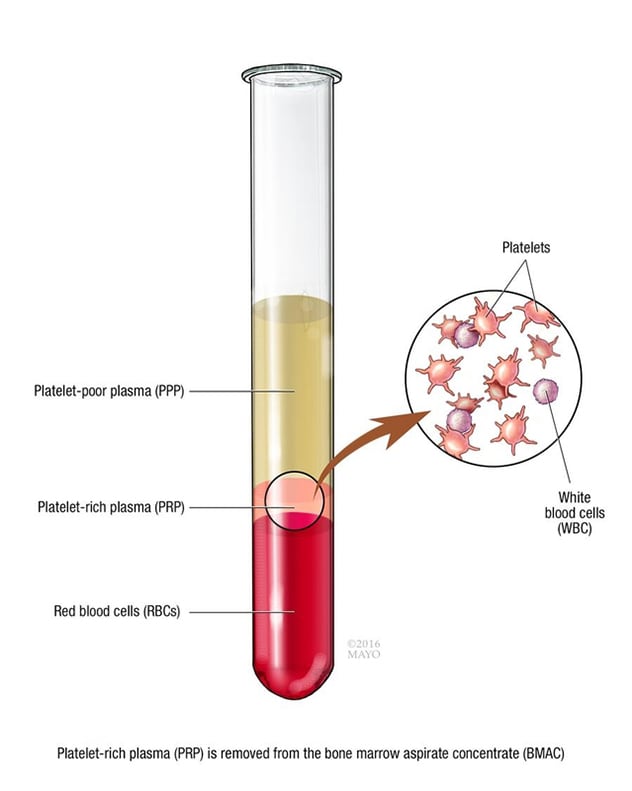Feb. 06, 2025
One avenue of regenerative medicine research is an emphasis on developing cell-based therapies to restore damaged joints. In this Q and A, Stephen J. Wisniewski, M.D., discusses the status of research focused on the use of platelet-rich plasma (PRP) and bone marrow aspirate concentrate (BMAC) injections to treat knee osteoarthritis (OA). Dr. Wisniewski is a physiatrist and sports medicine specialist at Mayo Clinic in Rochester, Minnesota, whose practice and research focuses include the use of biotherapeutics in the treatment of arthritis.
What does available published research say about PRP injections for knee OA?
There are multiple studies looking at injecting PRP for knee OA, but it's important to understand that there's a lot of variability in the studies. Some studies published in very reputable journals talk about PRP injections where the platelet count of the injection was only mildly elevated at 1.5 to 2 times blood level. Many of us would not even consider that PRP.
 Platelet-rich plasma (PRP) injections to treat knee osteoarthritis
Platelet-rich plasma (PRP) injections to treat knee osteoarthritis
Platelets are extracted from a vein in the patient's arm and concentrated using a centrifuge. The concentrate is then injected back into the patient's joint.
In a study published in 2021 in CARTILAGE, the researchers performed a meta-analysis of randomized controlled trials of PRP injections for the treatment of knee OA. They compared PRP to placebo, which was usually a saline injection. Looking at functional measures and pain scores, the results were really in favor of PRP. While not all PRP studies hit statistical significance, most indicated that PRP worked better than saline injections, especially when longer term results were analyzed. When comparing PRP to hyaluronic acid, PRP appears to outperform hyaluronic acid in most studies. One of the advantages of PRP is that its benefits can last longer than those seen with hyaluronic acid; from 6 to 12 months would be very common. So a higher percentage of patients typically respond to PRP, and the benefits can last longer.
Multiple studies have compared PRP with steroid injections for knee OA. Steroid injections sometimes produce better initial results, especially during the first 4 to 6 weeks after treatment, while PRP takes longer to work. But typically at 3 to 6 months after treatment PRP outperforms steroids.
What kind of patient outcomes are you and your colleagues at Mayo Clinic seeing when treating knee OA with PRP injections?
This is something we do frequently. To date, staff at Mayo Clinic in Rochester have treated more than 1,100 patients with PRP, with no serious adverse events. Most patients tolerate this treatment very well and experience only mild postinjection discomfort, with maybe a little bit of swelling. Many of our patients with knee OA report from 6 to 12 months of pain relief after treatment with PRP. We usually see a 60% to 70% chance of success, with success defined as at least a 50% improvement in pain and function for 6 to 12 months after the injection.
What does available published research say about bone marrow aspirate concentrate (BMAC) injections for knee OA?
Patients have heard a lot about the idea that injection of stem cells, or bone marrow aspirate concentrate (BMAC), can transform and potentially regenerate cartilage. Unfortunately, there's no data or strong evidence to back up some of the claims being made in advertisements. But let's talk about what studies have shown us thus far.
In a study conducted by researchers at Mayo Clinic in Florida and published in the American Journal of Sports Medicine in 2017, the researchers followed 25 patients with bilateral mild to moderate knee osteoarthritis. The researchers injected one knee with saline and one knee with BMAC, and they followed patients for six months. Overall, the researchers found no difference in pain scores between the two treatments.
In two prospective, randomized trials published in 2020 and 2022, researchers took 90 patients with mild to moderate OA and treated half with PRP injections and half with BMAC. In the first study, published in the Orthopaedic Journal of Sports Medicine in 2020, they found that there was no difference between the two groups in functional outcomes and pain scores 12 months after treatment. In the second study, published in the American Journal of Sports Medicine in 2022, they concluded that injecting BMAC had no advantage over PRP at 24 months after treatment.
To summarize, there have not been any definitive human studies that show that treatment with BMAC regrows cartilage. And the study data available to date has not shown any associated benefit(s) superior to PRP in the treatment of knee OA.
For more information
Filardo G, et al. PRP injections for the treatment of knee osteoarthritis: A meta-analysis of randomized controlled trials. CARTILAGE 2021;13(suppl):364S.
Shapiro SA, et al. A prospective, single-blind, placebo-controlled trial of bone marrow aspirate concentrate for knee osteoarthritis. American Journal of Sports Medicine. 2017;45:82.
Anz AW, et al. Bone marrow aspirate concentrate is equivalent to platelet-rich plasma for the treatment of knee OA at 1 year: A prospective randomized trial. Orthopaedic Journal of Sports Medicine. 2020;8:1.
Anz AW, et al. Bone marrow aspirate concentrate is equivalent to platelet-rich plasma for the treatment of knee OA at 2 years: A prospective randomized trial. American Journal of Sports Medicine. 2022:50:618.
Refer a patient to Mayo Clinic.